German national costumes for women, men and children. Ethnic garments
Traditions of folk costumes in Germany have a long history. As in many other countries, the German national costume have distinctive features that point to the region of residence, different class, position or profession of the person who wears them.
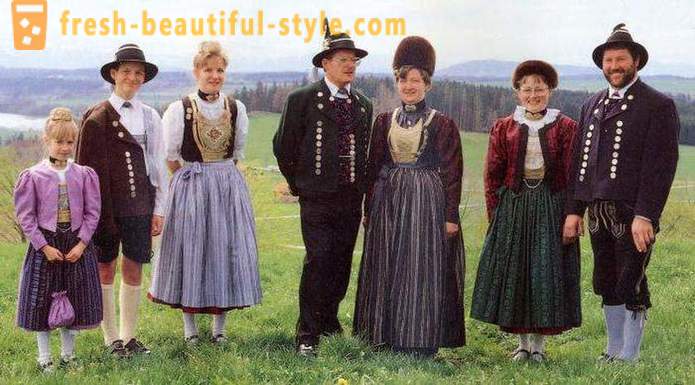
The history of costume in Germany
In ancient times, clothes designed only to warm the person. First the Germans put on animal skins and coats made of fur. Then ethnic clothing was supplemented by the elements: it buckles chipping coat, etc. The women wore sleeveless shirts from a simple homespun cloth with red stripes, and the top also wore animal skins, and later - hooded cloaks.. Fabrics made of wool and linen, and the linen was mainly on women's shirts.
Then, a few centuries Germany was under the influence of the Roman Empire, and her clothing, though not immediately, but caught the Germans. Reformation of the 16th century had a profound impact not only on art and religion, but also revolutionized the German costume history. Early forms of clothing in the 16-17 centuries. It became the basis, helped to create in the future German traditional costume.
Clothing is gradually acquiring the European look, however, by the existence of a plurality of principalities in Germany, the suit is also becoming more diverse, pointing to their appearance on the local customs, class and profession.

Determination Suit
Costume - a combination of several components of clothes and other items that are made in the same style. History of Costume in Germany has always been a reflection of the differentiation of society. A variety of state, princes, and city laws pointed to different classes a kind of costume.
There were restrictions on the bright colors of the clothes: ordinary Germans could wear only gray or brown. Particularly difficult for ordinary people was a decree to ban the wearing of articles made with his own hands. For example, skilled workers to work with laces could not even wear them. It was only after the lifting of restrictions in the early 18th century. German folk costume had the opportunity of free development. The appearance of the costume was influenced by the geography of the terrain, fashion and belonging to a particular class. Only the wealthy gentlemen could wear expensive furs and jewelry.
The German national costume: the description of the
Traditional costume in Germany was formed gradually over a 16-17 cc., Using the basis of medieval clothing and the impact of urban fashion. Different areas of Germany had different tendencies in the national costume. According to the suit could determine marital status (woman, married, divorced), social status, profession and place of residence.
Suit in Germany was divided into 2 types: trahten (male and female) and dirndl (only female). The name comes from the German dirndl names of female servants and historically connected with clothes Alpine peasants.
The name refers to the traditional costume traht in Germany, Austria and Liechtenstein. It is the foundation of his linen with lots of embroidery, in some areas it is decorated with beads, which is a sign of wealth holders. In the old days was part of the dowry trahten German brides, sometimes wore to the wedding. One of its distinctive parts - a large white apron and beads on the breast in women's costume.

Suit Features: fabric, embroidery
Fabrics for costume chosen depending on the geographical location of the German region. For example, in warmer areas used flax in mountainous regions - a thick cloth made of wool (lodena). Colors for everyday wear were gray or brown, on holidays wore blue or blue.
National costumes German wealthy citizens were more colorful and bright, decorated with embroidery and fur. Colors used green and red. The embroidery is often used heraldic symbols, floral designs, and others.
Women's costume
German national costume (female) dirndl consisted of such basic elements: bodice and fluffy jacket (jacket), a skirt with numerous assemblies (200), which was sewed from a thick coat, an apron and petticoat. In the region of Hesse were from several skirts of varying lengths, and was made to wear a dress in Bavaria. Skirt length in different regions differed from the longest (to the ground) - to mid-calf. Corsages have very different shapes and colors, depending on the terrain. The most widely used color - black. Corsage was on whalebone, decorated with gold and silver embroidery and laces or ribbons chain.
Apron or apron was monophonic or striped, always decorated with embroidery and lace. Apron material: linen, silk and cotton. Apron bow sprang up, in which the location of the determined position of women: in the middle - a widow, left - not married, right - married.
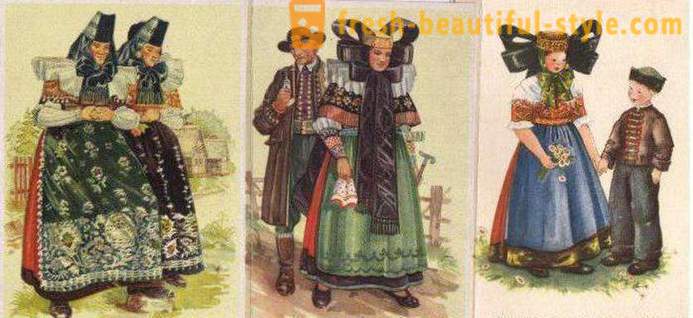
In order to protect against bad weather, put on top of a woolen shawl, and in the early 19th century. It became fashionable capes with long sleeves in small folds. Another national ornament were removable collars, capes. A wide variety of different hats.
Women's hats
German women and men are considered unacceptable to walk without a hat, with the exceptions of only young unmarried girls. German ethnic clothing has always included scarves, straw hats, bonnets.
Peasant women wore headscarves, which were needed when working in the field and at home in winter fur hat worn on top or elegant hat. In the villages and the main subject of the female costume he was considered a cap on his head, adorned with ribbons, artificial flowers, lace.
In Swabia in traditional women's costume included a straw hat "bollenhut" on which were sewn on top of the red woolen tassels. This bright decoration allowed to wear girls starting from 14 years. For adult female black pompons made.
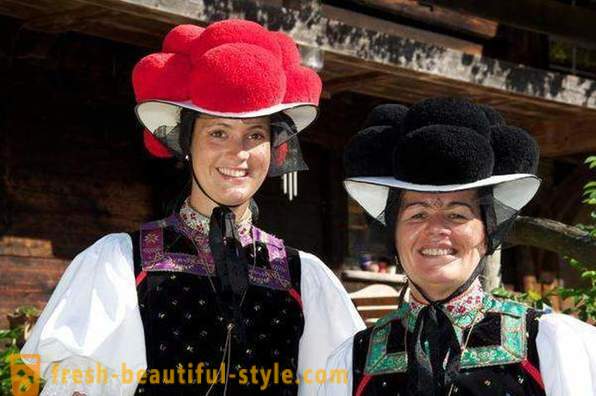
Straw hats with various ornaments like were in use in other parts of Germany, but could only wear them, unmarried women, after marriage - only black cap.
In other regions were in vogue "gold caps", which before was decorated with black translucent ribbons stacked in a special way.
Male German costume
German national costume for men includes a shirt, made of two panels with inserts for sleeves, and rather short leather pants (Lederhose). pants length can vary: 3/4, below the knee or above. Be sure to attend pocket hunting knife, closing on the valve. By relying pants suspenders or straps with a jumper, embroidered, sometimes strap. The most frequently used motif embroidery - edelweiss. Pants have a front flap, embroidered, which fastens with buttons. At the bottom, they are tightened with laces and tassels.
Short pants for men in Germany was not always the case. Thus, in the 19th century. gained popularity brought from Paris, long pants, made of two leg held together. To vest they were fastened with special hooks.
The German men's suits are also supplemented by a waistcoat, put on a shirt, and on top - double-breasted frock coat (Loden). And married men had to wear only long black coats, and young - different colors and shorter.
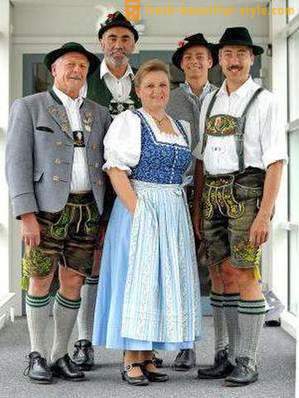
Another element - a tie in the form of a long tape. Be sure to color the hat was present, narrow field which were decorated with feathers and brushes of hair.
On foot, men wore high socks or stockings (leferl), as well as leather shoes with thick soles. Modern leferli steel golf, made of a thin coat.
National Shoes
Women's shoes are mainly made of leather, low-heeled or platform, fastens the buckle. She was put on a knitted stockings (usually white or blue). In the southern areas with warmer climates peasants wore shoes made of wood and straw.
There is also a great variety of shoes for the German peasants, inspired by the goat's hoof. Such clogs with raised open heel, with the cut edge around the ankle, the sock had type boats. They provided good stability when walking on mountain roads. In the 19th century. its glorify English travelers, who made the ascent of the Alps, and now this has become a classic shoe.
The National Costume Bavaria
National Bavarian costume - one of the most interesting and popular even now. Due to the harmonious colors, the best and fashionable style and comfort while wearing it won the love not only of Germans. Such a suit people of Bavaria put in our time, and not only on holidays, but also on weekdays.
There are different costume options: casual and festive, summer and winter. The cost of the kit is not cheap - about 700 euros.
The most widely used fabrics - linen, wool and leather. In such suits materials found in different colors, most often blue, green, red and pure Bavarian national colors - white and blue.
The main attribute in the female part dirndl Bavarian suit including white blouse (in holiday embodiment sleeves made wider), corset clasp or lacing, broad pleated skirt and bright apron. In the old standard length skirt was considered "the height from the ground of a beer mug" (27 cm), it is now any selected.
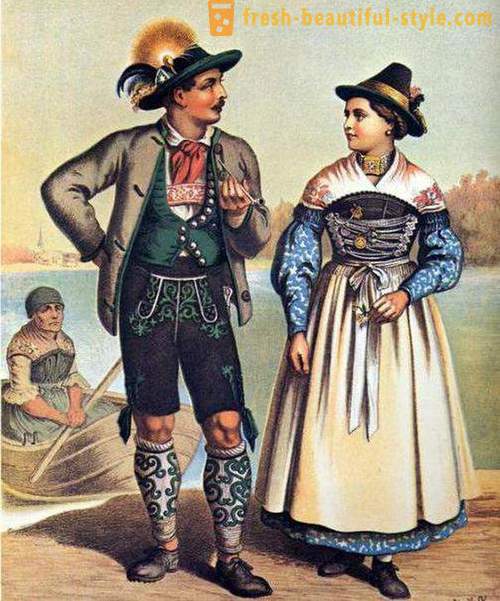
Women's Accessories: scarf, bag, black shoes with a buckle, hat and ornaments on the neck. Winter kit is sewed of a warm wool fabric and also includes a flared coat, embroidered.
Male Bavarian costume (traht) consists of a light jacket, vest or coat, narrow knee-length pants, stockings, and shoes with a buckle; addition is a tie-belt.
Children's Suits
Children's costumes in Germany are an exact copy of the adult.
German national costume for a boy - a snow-white shirt and short breeches of thick fabric with suspenders, vest and boots. To him also fit hat with a feather.
When the family goes for a walk, the clothes of adults and children specially picked by color and the similarity of style. German national costume for girls is almost exactly the same as the famous dirndl: vest sundress or a skirt, put on the white shirt with lace. Put on top of a bright apron.
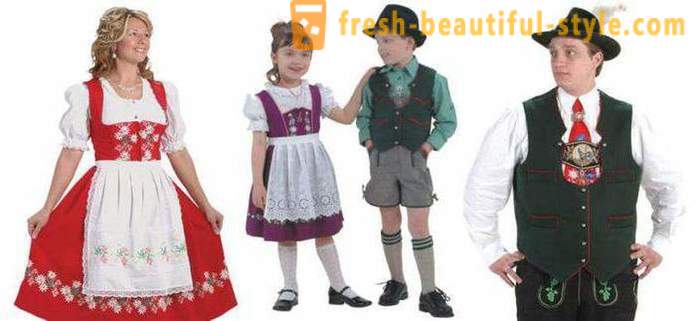
The German national clothing and its relevance
Modern clothes look not always individually, so ethnic costumes or motives in modern clothes have become popular more and more. Old national German costumes differ originality and high comfort. In Germany, their elements and decorations are often used in the collections of contemporary designers.
Especially popular are the costumes during festivals, celebrations and weddings. Most often, a demonstration of the garment can be seen at Oktoberfest, the annual September beer festival in Munich (held for more than 180 years), or the Day of German unification (3 October).













































